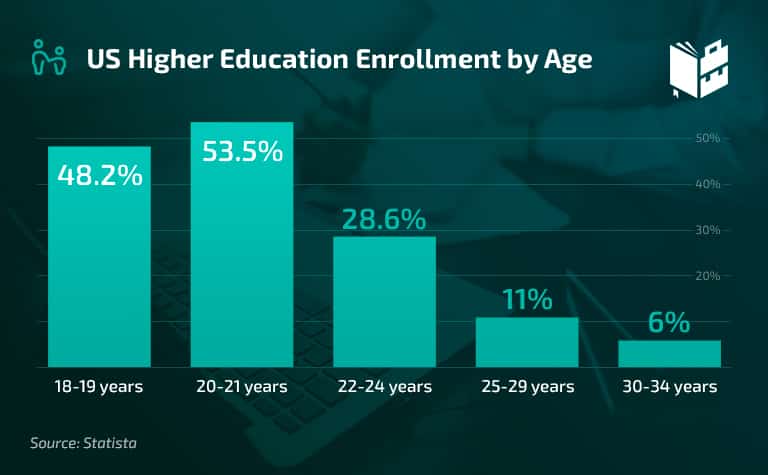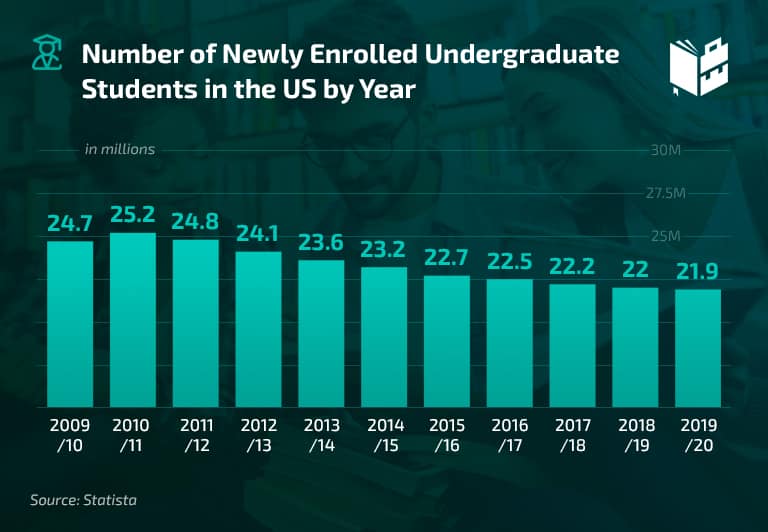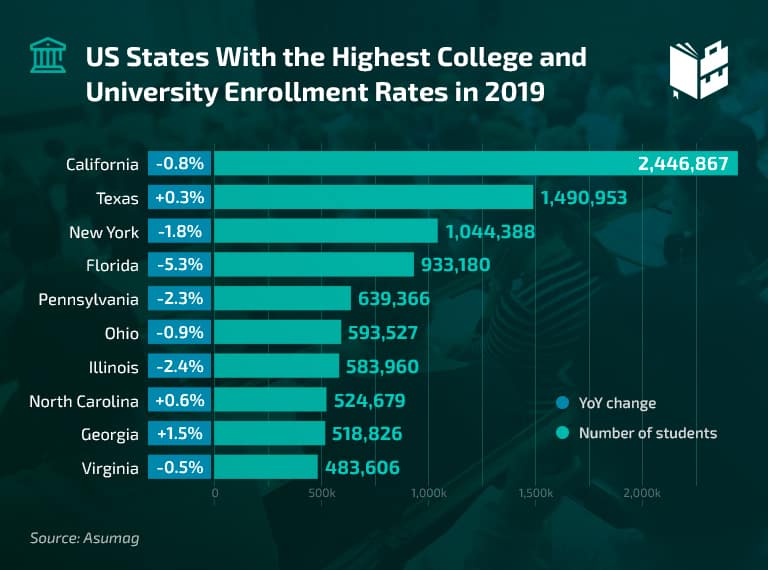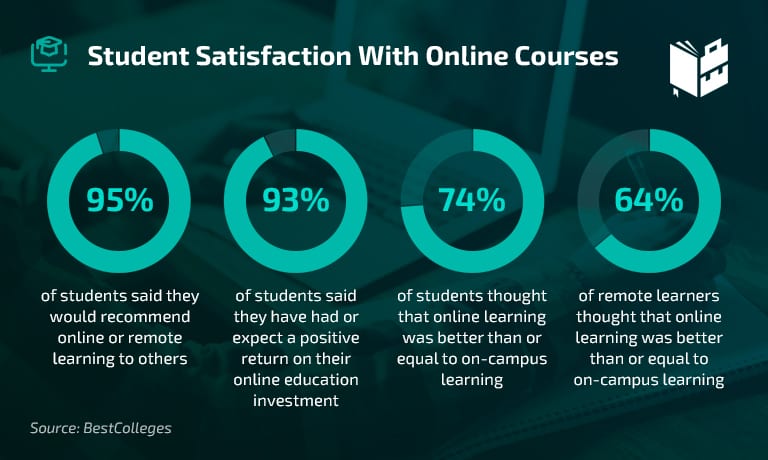College enrollment statistics over the last 60 years have been steadily increasing, and it seems that college has truly become a career staple, with most jobs now requiring a degree.
While it seemed for decades that post-secondary education was the only way to get a well-paying job, the rising cost of tuition, lack of job return on degrees, student debt crisis, and financial and personal impacts of the coronavirus pandemic seem to be shifting this perspective.
These stats look at the cost, demographics, and prevalence of college enrollment over the decades in the United States.
Relevant College Enrollment Trends (Editor’s Choice)
- In 1965, 5.92 million people enrolled in college
- According to research, there are 3 million more female college applicants than males each year
- Little more than half of the individuals enrolling in college are ages 18-19
- Individuals with a good financial background are 50% more likely to enroll in college
- The student enrollment rate reached its all-time high in 2010
- In 2019/2020, 21.9 million individuals enrolled in colleges in the US
- California has the highest enrollment rate in the US
- Affordability is a major factor individuals consider when appraising online college courses
College enrollment rates have increased exponentially in the US since 1965. Based on college student statistics, the total number of individuals seeking higher education has increased year after year as social equality gave more access to the marginalized populations, and a degree became a staple for landing a decent paying job. College tuition has also gone up, however, causing more students than ever to go into debt for their education.
1. In 1965, 5.92 million people enrolled in college.
(Statista)
56 years ago, 5.92 million individuals enrolled in college in the US, based on college enrollment stats by year. Out of these people, 3.97 million sent their application to public universities, while the remaining 1.95 million enrolled in private institutions. By 1975, this number doubled, with roughly 11.18 million people enrolling. Looking forward to today, almost 20 million people enroll in college every year.
2. The average cost of yearly tuition in 1969 was $329.
(Yahoo Finance)
The cost of tuition has risen far beyond the rate of inflation throughout the decades. When adjusted for inflation, the cost of yearly tuition in 1969 was $2,323, while college enrollment data shows that it has now increased by over 340%.
This excessive rise in cost has spurred a full-on student debt crisis in the US and is one of the reasons enrollment may now be declining after years of expansion. The current grand sum of US student loan debt amounts to a devastating $1.46 trillion, doubling in the last decade alone.
College Enrollment Demographics
The demographics of college have changed significantly over the years, from exclusively young, white males to all kinds of people being granted access to higher institutional learning. These statistics highlight the main demographics of college students across age, race, and gender in the United States.
3. There are 3 million more female college applicants than males each year.
(Admissionsly)
According to the United States college enrollment statistics, starting in 1980, female students have begun to surpass male students in numbers little by little. For the last ten years, the difference between gender statistics has been quite significant. The total number of females enrolled in college holds at around 11.5 million, compared to just 8.4 million males.
4. The rate of enrollment for African American students between 2000 and 2016 was 30-36%
(NCES)
The racial demographics of college enrollment are a great indicator of social change in the United States. The college enrollment statistics by race show that since 1965 there has been a substantial increase of people of color in post-secondary schools. In the last 20 years, rates have stayed relatively constant, however, with Hispanic young adults ranging from 22-39%, American Indian/Native’s at 19%, and Asian young adults at 58%.
5. A little more than half of the individuals enrolling in college are ages 18-19.
(Statista)
College enrollment statistics show that the majority of people studying at institutions of higher education are between 18-21 years of age. The lowest percentage by age group is individuals who are 30 to 34 years of age, at a 6.3% prevalence rate.

6. Individuals with a good financial background are 50% more likely to enroll in college.
(Admissionsly)
According to education statistics, college has always been an investment, although more-so than ever in today’s modern age. Due to both family legacy and accessibility, those with a better financial background are more likely to attend after acquiring a high school diploma.
College Enrollment Statistics by Year
While college enrollment over the last 50 years has steadily increased, that trend is beginning to change. Due to rising costs of tuition and poor job market outcomes, enrollment statistics show a shift in the exponential curve of college applications.
7. The student enrollment rate reached its all-time high in 2010.
(Statista)
The last accessible data on this topic specifies that, after long years of steady incline of the college enrollment rate, it finally reached its all-time high in 2010, with 25.2 million students choosing to apply for universities.

8. In 2019/2020, 21.9 million individuals enrolled in colleges in the US.
(Statista)
When it comes to the number of enrolled students for 2019/2020, the college enrollment rate has declined since its peak in 2010. According to Statista’s report, the number of enrolled students in 2019/2020 was the lowest it’s been in the past decade, suggesting a gradual decline in college enrollment.
9. The college enrollment rate is projected to reach 19.78 million in 2021.
(Statista)
The College Enrollment Statistics for 2021 predict that the number of people enrolling in college this upcoming year will still be close to $20 million students. Considering that predictions were made before the onset of the global pandemic, this may no longer be the case. As colleges and universities were forced to close their doors and shift courses into online platforms, some students hit by the pandemic may decide not to go back to school this year.
College Enrollment Statistics by State
The state of college enrollment has been shifting over the last 10 years, no longer reporting a constant increase across the country. In fact, many states reported a decline in enrollment. The three top states for the number of students enrolled were California, Texas, and New York.
10. California has the highest enrollment rate in the US.
(Asumag)
California regularly finds itself at the number one spot for college enrollment rates by state. While many states reported a decline in 2019, California had two million students enroll, an almost 1% increase from the year before.
11. Roughly one and a half million students enrolled in college in Texas.
(Asumag)
Texas was the runner-up to California in 2019 for college enrollment. They still saw an increase of 0.3% and more than half a million more students than in New York.
12. New York is considered the top third when it comes to high college enrollment rates.
(Asumag, Forbes)
Third place on the top highest college enrollment list is New York, with just over 1 million students enrolling in post-secondary institutions in 2019. The world-known city maintains its position at the top of the list despite the fact that it witnessed a 1.8% decrease in enrollment compared to the year prior. While New York is home to some of the most prestigious universities in the world, the institutions that were hit the hardest were community colleges.

Online College Enrollment Statistics
While the introduction of the online classroom isn’t entirely new, it has become a central tool in continuing education. Still, COVID-19 restrictions for social distancing has changed how students may feel about attending school in mass lecture halls, making online learning even more appealing.
13. Affordability is a major factor individuals consider when appraising online college courses.
(QualityInfo)
There are many things to consider before applying to a university program, and cost is a major concern for most students. US college enrollment rate statistics show that more than 50% of individuals indicate affordability as the number one most critical factor when searching for and appraising online college courses.
14. 50% of students who attend online colleges are millennials.
(QualityInfo)
While the majority of students who attend in-person classes may be between 18 and 22 years of age, the online demographics differ significantly. Online classes offer flexibility for students who may have other responsibilities such as full-time jobs or children at home. Notably, US college enrollment statistics show that the majority of online scholars are between 23 and 38 years old.
15. Roughly 30% of US students have completed at minimum one online course in their lifetime.
(Guide2Research)
The latest available data shows that 30% of students have completed at least one online course. The percentage of students who enrolled in online courses increased exponentially in 2020 due to social distancing, based on an analysis of college enrollment rates over time.
16. 94% of online students are satisfied with web-based courses.
(BestColleges)
Especially with improvements in online learning platforms, most students who participate in online learning feel satisfied with their experience. Notably, 95% of them said they would recommend taking distance learning to another student. Completing an online college program can save you a significant amount of money, time and offer greater flexibility.

College Enrollment Trends: Community College
There are many different types of post-secondary education options aside from large and expensive Universities. Community colleges make the majority of institutions for higher learning in the US. Offering more affordable courses, shorter programs, and other technical degrees, community colleges offer many great alternatives to the standard four-year bachelor’s degree.
17. There are a little over 1,000 community colleges in the United States.
(Asmissionsly)
According to community college enrollment statistics, in 2019, there were a total of 1,051 community colleges statewide. Community colleges range from being completely private to completely public to some mix of independent funding with public sources.
18. In 2019/2020, tuition fees at community colleges were around $3,700.
(Higheredtoday)
Compared to other colleges and universities where the yearly tuition can surpass $10,000 a year, community colleges are a lot cheaper and more accessible for students. Statistics on enrollment rates for college report that the annual tuition fees for community colleges were almost one-third cheaper than universities in 2019/2020.
19. A total of 41% of undergraduates enrolled in community colleges.
(Higheredtoday)
Community colleges play a significant role in supporting undergraduate students and student’s looking to achieve a bachelor’s degree. Almost half of undergraduate students are enrolled in community colleges, as opposed to universities. According to the community college enrollment trends, a vast number of these students are either Native American or Hispanic, showing the importance of these institutions in the redistribution of knowledge in the United States.
20. Community college enrollment is down 9.4% compared to 2019.
(CCDaily)
The global pandemic has affected higher learning in more ways than one. While some speculated that community colleges may thrive after the changes imposed by the pandemic, the result has been the opposite.
One of the perks of community colleges is that they offer a more ‘hands-on approach to learning, which has not translated well to an online atmosphere.
College Enrollment Statistics – Conclusion
Until recent years, the college enrollment rate has been steadily increasing. With hopes of pursuing higher education in return for better jobs afterward, most young people enroll in college. The numbers are changing; after peaking in 2010, post-secondary enrollment is slowly declining.
With a massive student debt crisis, high tuition rates, and financial trouble surfacing due to the effects of the coronavirus pandemic, many students are choosing to delay enrollment in college.
Enrollment numbers for colleges show that online learning has been a good fit for many students, and most students even before the pandemic had participated in an online class. Community colleges, however, with more hands-on and in-person approaches, have seen their enrollment deeply decline due to the ability to only offer online education.
At one time, it seemed that college was the only path to a good career, but as the world changes, many are starting to reconsider this ‘mandatory’ step in their journey.